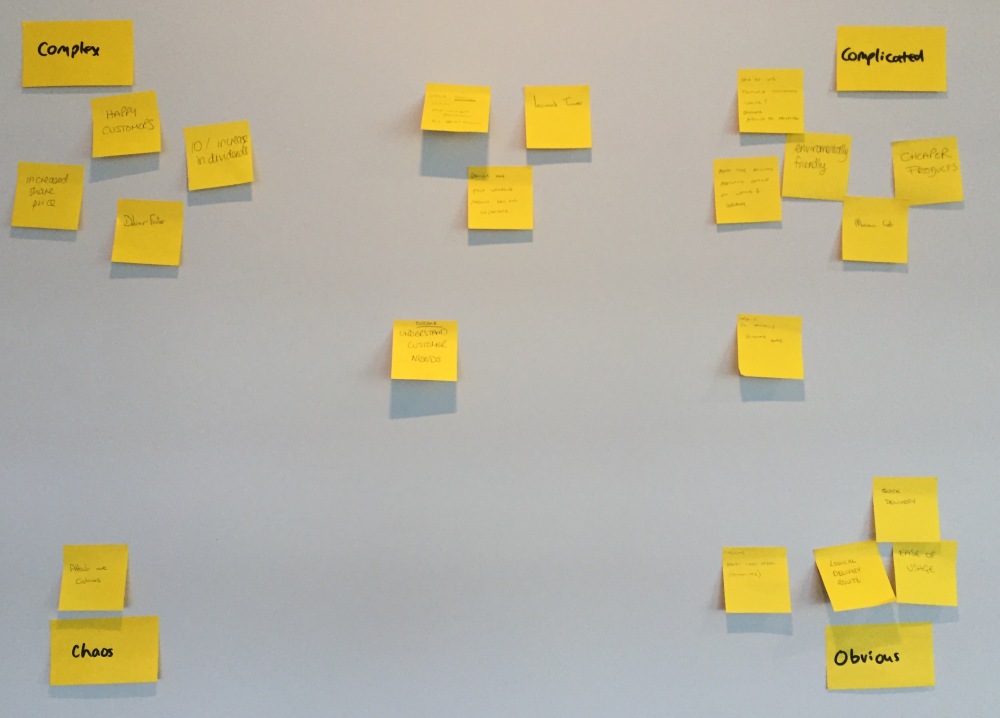I have been incorporating two new tools in my workshops: Clean Language (which could be described as a coaching tool) and the Cynefin Four Points Contextualisation exercise. Here’s how we put them to use.
Clean Language
You’re probably familiar with the idea of coaching often taking the form of identifying a goal, then helping the client focus on the process of getting there. The GROW model [1] is probably the canonical example, a conversation structured – explicitly, or implicity in the mind of one or both participants – along these easily-remembered lines:
- Goal
- Current Reality
- Options
- Way forward (or Will)
Clean Language [2, 3] covers some of the same ground, using language particularly good at (among other things) getting to outcomes (the Goal in GROW model), and doing so in a noticeably judgement-free manner.
There is some discipline involved:
- Sticking to the the preferred prompts
- Incorporating the client’s language
- Note-taking
I’m not skilled enough myself to do all of those simultaneously and I certainly don’t expect others to do so without practice! It is however a fun and useful exercise for workshop participants to take the roles of the client (with real or imagined problems, challenges, or potential solutions to explore), coach (whose job it is to guide the exploration), and scribe (who writes down anything that sounds like an outcome).
In our exercise, the coach is allowed only these prompts (a small but important subset of the whole):
- “What would you/X like to have happen?”
- “(And) then what happens?”
- ”(And) what happens before X”?
- “What kind of X?”
- “Is there anything else about X?”
In the context of the exercise, first two of those are the most important, taking the conversation away from problems and solutions and towards desired outcomes. The middle one has multiple applications; here it could be used when the coach does not grasp the mental leap the client has made. The last two are more exploratory, likely taking the conversation into areas more metaphorical, descriptive, or detail oriented (perhaps too much so, but that’s the choice of the coach).
No big explanation needed – we try it, and it works! We’re just dipping our toes in the water, but there’s the opportunity afterwards to explain that we have here a set of tools that could be of great value to anyone interested in further developing their coaching skills.
Four Points Contextualisation
The nuts and bolts of the Cynefin Four Points Contextualisation exercise are well described in the first part of this article from the Adventures with Agile blog: Cynefin Review Part 7 – Finding Your Place on the Framework.
More interesting to me than the mechanics have been some of the implications. This exercise powerfully illustrates some important things:
- The importance of choosing an implementation approach that is appropriate in context, whether that’s one based on careful analysis and planning, on experimentation, or on direct action
- The range of opinion on what’s appropriate, given any particular outcome or solution
- The strength of our personal biases in favour of some approaches over others, making us – myself very much included – vulnerable to blind spots and at risk of judging others quite unfairly
Interesting stuff! Here’s the output from one such exercise (on the Featureban scenario, not anything sensitive):

Opportunities for you to give them a try
Both tools are now standard elements of the Agendashift debrief/action workshop, with the option to remove or gloss over them if a shorter workshop is called for. For the 1-day training workshop, they’re both optional extras – choosing them will be at the expense of other material. [Note: with some big site changes pending they’re not in the blurb yet]
There’ll be opportunity to see one or both of them in action at these upcoming events:
- Lean-Agile Scotland (5th-7th October), workshop with Karl Scotland
- Agile Nottingham October Meetup (19th October), the exercise in the later part of the evening

